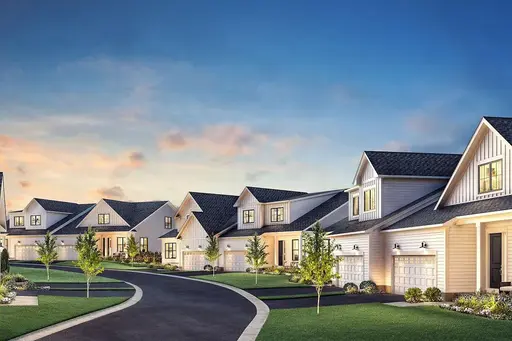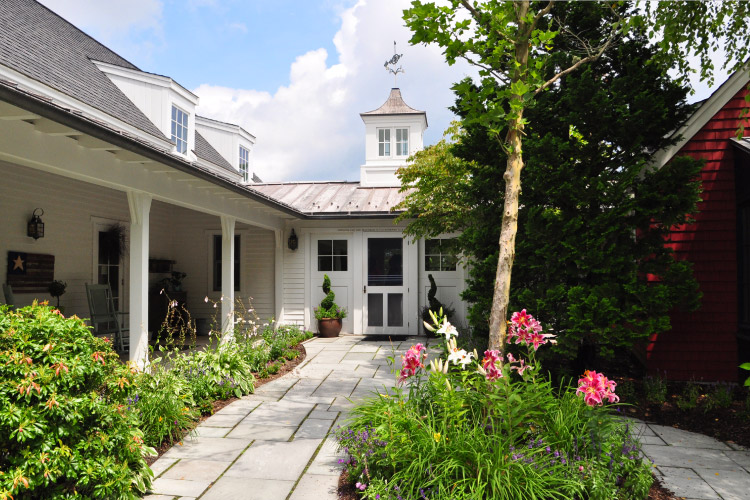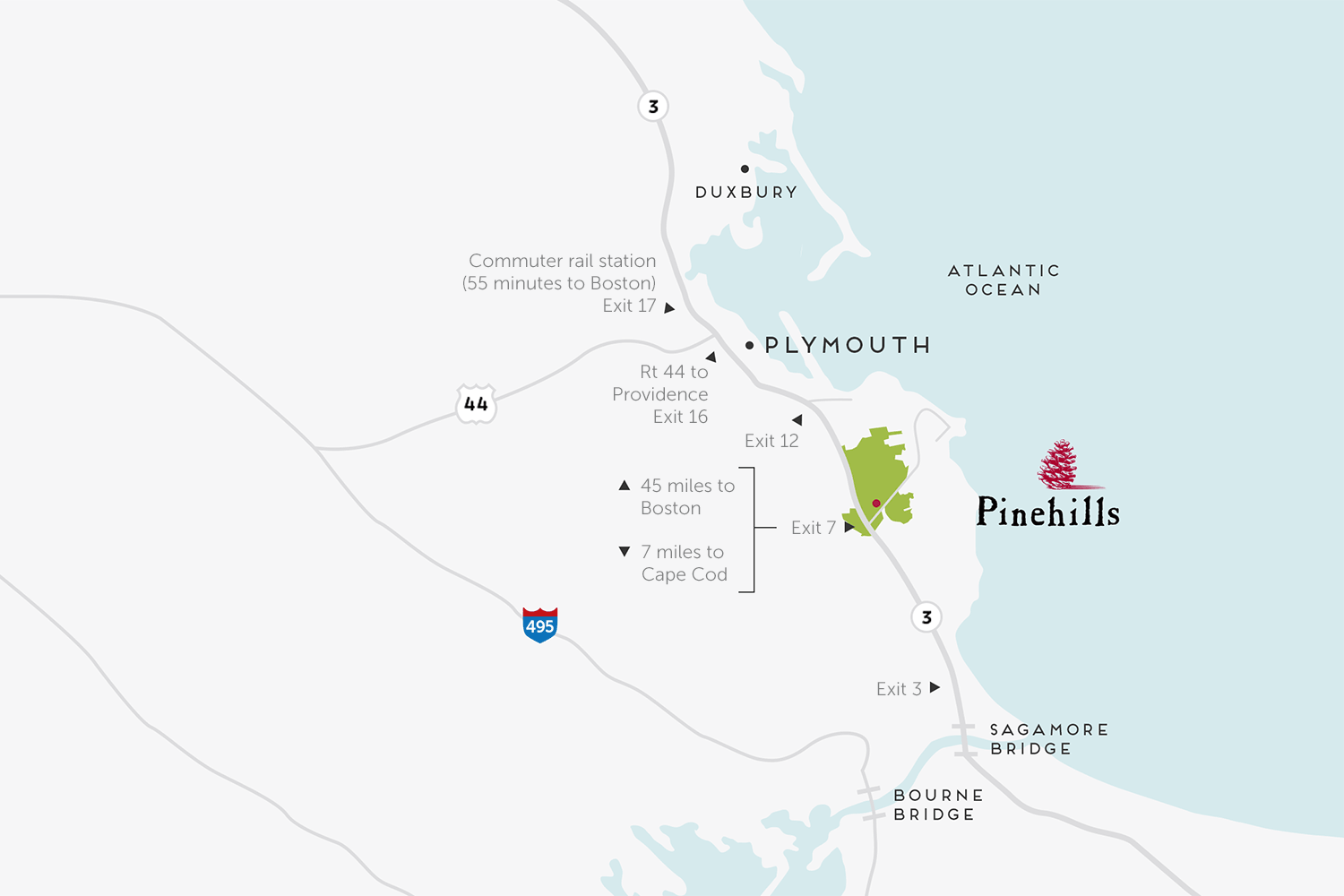
The term "housing development" carries with it some preconceived notions: cookie-cutter houses set in tidy rows on large, treeless lawns, with a wide, straight street running down the middle. Not so The Pinehills, a 3,174-acre development off Exit 3 of Route 3 in Plymouth, which houses 1,380 families. Its unique approach to designing a community that is both sustainable and beautiful has allowed the development to continue to expand and be successful, even as many homes elsewhere are dropping in value and remaining unsold.
Stand on the balcony of the Summerhouse welcome center and look out over the pine trees. Several houses are just a stone's throw away, and yet only a few are visible at all, if you really look. Here is one principal behind the design of The Pinehills: houses should sit on the edge of a hill and look down onto open space, which sits in the valleys. Every house, whether it is worth $300,000 or $2 million, has a view — and privacy.
"Putting a house where it really belongs is not a math problem, it's a qualitative problem," said Tony Green, managing partner of Pinehills LLC. As former principal of the Green Company, he was part of the team that started The Pinehills — New England Development, Wallace Associates and The Green Company.
The first house in The Pinehills was built in June 2001, after a five-year permitting process intended to preserve the beauty of the Pinehills land, just four miles from the ocean and the highest coastal point from Maine to North Carolina. For every one acre of land that is developed, two more acres are preserved as open space.
There is a lot of flexibility to the Pinehills permit; the town should be commended for placing trust in the developers, Green said.
The company has rewarded the trust with a site that is getting national recognition for its innovation and sustainability. It won Best Smart Growth from the National Builders Association, Grand Award for Best Mixed-Use Community from Builder Magazine, the Best Master-Planned Community in the Nation, 2003, from the National Association of Home Builders and the Award for Innovation from the Massachusetts Environmental Council.
In addition, the community has had tax benefits for the town beyond what was predicted; The Pinehills will pay $8.8 million in taxes to the town of Plymouth this year. Only ten cents on the dollar goes to supporting the development, which has its own trash pickup, plowing, walkway shoveling, landscaping and road maintenance. The town is left to provide police, fire and schools.
Plenty of characteristics make the community unique. There are narrow roads that twist and curve to avoid the oldest trees and maintain the view, walking trails that connect the different neighborhoods and shared driveways at some homes to reduce the impact on the environment.
Green sums up The Pinehills' quest perfectly: "How do we site things where they belong, preserving the things Mother Nature has given us to create a more valuable and more beautiful home?"
The Pinehills sold more homes last year than it did in 2008, with 125 total for 2009. This year is looking even more promising; the development is eight sales ahead of last year's year-to-date numbers. The average price of a home sold is also slightly up this year.
The Pinehills' continued success proves that people are willing to pay for a quality product, Green said. "They're coming here because they like the idea of a rural, natural environment," Green said.
In addition, the developers continue to offer potential homebuyers new choices. In the past year, three new home types were introduced. With nine builders as well as a resale team, there truly is something for everyone. Care is taken to keep up with current trends in homes, such as a first floor master bedroom in most types of homes. Custom houses are also available.
Part of the development's success also hinged on planning ahead. In 2006, when gross home sales in Massachusetts dropped below 2005 numbers, the company advised its builders to stop building homes that were not yet sold. The builders all agreed, and The Pinehills was prevented from having to scramble to sell homes.
The Pinehills is also the site of the HGTV Green Home 2010, a sustainable cottage house near the Village Green, the community's center for retail, food and services. The two-bedroom, 2.5-bath home fronts the future site of a community park and has countless sustainable features, such as recycled materials in the floor, walls and ceilings, pervious pavers on the walkway, a high-efficiency hot water heater and solar panels. The family that won the home saw it in person for the first time in mid-July, Green said.
The icing on the cake is all the amenities that come with a home in The Pinehills. All residents are welcome at the Stonebridge Club, where there is a 25-yard lap pool and a kiddie pool, an exercise room, a multi-purpose room. Also available is information on a number of activities, including groups like the Working Women's Club or the Hiking Club, classes on Tai Chi and CPR, or events like Movies on the Green, which are shown on a big screen on the Village Green throughout the month of July. There are also three golf courses, two of which are public, a post office and many shops and services.
Because there is no commercial development from Exit 2 to Exit 5 on Route 3, the Village Green businesses attract more than half their business from outside The Pinehills.
The Pinehills is still unfinished, having built less than half of its planned homes so far. Green is optimistic about the development's future success and believes that many of the design principles employed there could start showing up in other developments as well.
"I think the state is going to help everybody move in this direction," he said.
"It's not just the way in which we disturb less; it's all the community stuff that comes with it."





